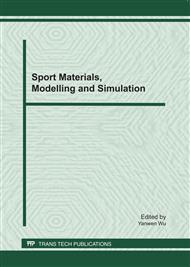[1]
Marksjo P & Gipps B.: A Micro-simulation Model for Pedestrian Flows. Mathematics and Computers in Simulation, 27(2), (1985), pp.95-105.
DOI: 10.1016/0378-4754(85)90027-8
Google Scholar
[2]
Shigeyuki Okazaki S M: A Study of Simulation Model for Pedestrian Movement with Evacuation and Queuing. (1993).
Google Scholar
[3]
Victor J. Blue J L A: Cellular Automata Model of Emergent Collective Bi-Directional Pedestrian Dynamics, Reed College, Portland Oregon. (2000).
Google Scholar
[4]
Kirchner A., Namazi A., Nishinari K., Schadschneider A.: Role of Conflicts in the Floor Field Cellular Automaton Model for Pedestrian Dynamics. Pedestrians and Evacuation Dynamics, in proceedings of the 2nd international conference. E.R. GaleaEditor. (2003).
DOI: 10.1007/978-3-662-10583-2_54
Google Scholar
[5]
Helbing, D. & P. Molnar: Social force model for pedestrian dynamics, Physical Review E 51(5), (1995), p.4282–4286.
DOI: 10.1103/physreve.51.4282
Google Scholar
[6]
Craig Reynolds: Steering Behaviors for Autonomous Characters, http: /www. red3d. com.
Google Scholar
[7]
A. Nakayama, K. Hasebe, and Y. Sugiyama: Instability of pedestrian flow and phase structure in a two-dimensional optimal velocity model. Physics Review E, 71: 036121. (2005).
DOI: 10.1103/physreve.71.036121
Google Scholar
[8]
J. Izquierdo I. Montalvo, R. Pérez and V.S. Fuertes. Forecasting pedestrian evacuation times by using swarm intelligence. Physica A. 7(388), (2009), pp.1213-1220.
DOI: 10.1016/j.physa.2008.12.008
Google Scholar
[9]
Maw, J. & M. Dix: Appraisals of station congestion relief schemes on London Underground, Proceedings of PTRC Seminar 335, (1990), p.167–178.
Google Scholar
[10]
S G K.: Crowd Dynamics. Warwick University. (2000).
Google Scholar
[11]
Hoogendoorn, S.P. &P.H.L. Bovy: Pedestrian route-choice and activity scheduling theory and models, Transportation Research Part B 38 (2004), p.169–190.
DOI: 10.1016/s0191-2615(03)00007-9
Google Scholar
[12]
Li Dewei: Modeling and Simulating Passenger Flow of Urban Railway Traffic, PhD Dissertation of Beijing Jiaotong University. (2007).
Google Scholar
[13]
Lovas G G: Modeling and Simulation of Pedestrian Traffic Flow. Transportation Research-B, 28B (6), ( 1994), pp.429-443.
Google Scholar
[14]
D. H. Rothman and S. Zaleski: Lattice-gas models of phase separation: Interfaces, phase transitions, and multiphase flow. Rev. Mod. Phys., 66, (1994), p.1417.
DOI: 10.1103/revmodphys.66.1417
Google Scholar
[15]
Gordge, R.M. & A. Veldsman: Planning for pedestrians: Friendly, safe and viable transportation station environments, In: Freeman & Jarnet, (eds. ), Urban Transport Policy, Balkema, Rotterdam, The Netherlands, (1998), p.481–487.
Google Scholar
[16]
Schelhorn, T., D. O'Sullivan, M. Haklay & M. Thurstain-Goodwin, STREETS: An agent based pedestrian model, In: Proceedings of Computers in Urban Planning and Urban Management, (1999).
Google Scholar
[17]
Serge P. Hoogendoorn P H L B: Gas-Kinetic Modeling and Simulation of Pedestrian Flows, Transportation Research Board, (2000).
Google Scholar
[18]
Teknomo, K., Microscopic Pedestrian Flow Characteristics: Development of an Image Processing Data Collection and Simulation Model, PhD thesis, Graduate School of Information Sciences, Tohoku University. (2002).
Google Scholar
[19]
MacDonald M.: STEPS Simulation of Transient Evacuation and Pedestrian Movements User Manual, Unpublished work. (2003).
Google Scholar
[20]
Special Report 209: Highway Capacity Manual. Washington, D.C.: Transportation Research Board, National Research Council. (2000).
Google Scholar


